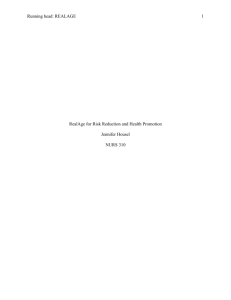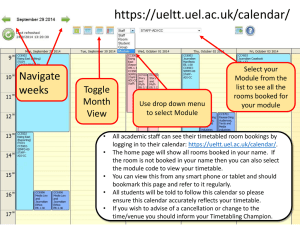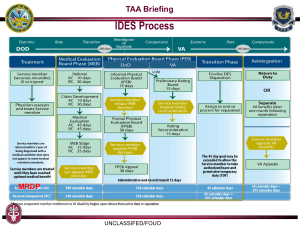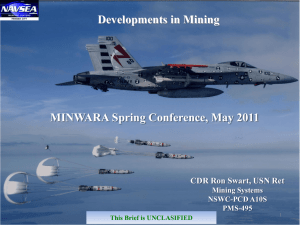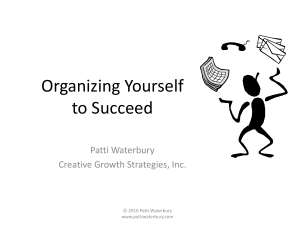Presentation - Johnston
advertisement
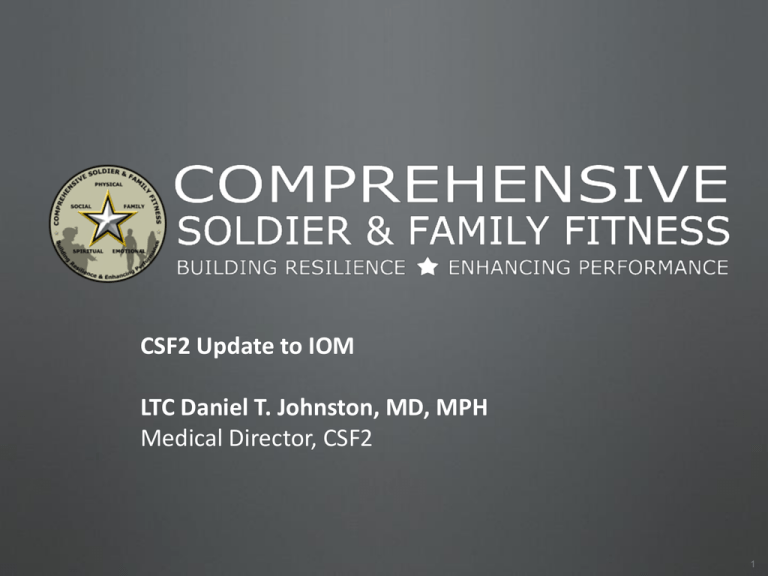
COMPREHENSIVE SOLDIER & FAMILY FITNESS BUILDING RESILIENCE ENHANCING PERFORMANCE CSF2 Update to IOM PCC LTC Daniel T. Johnston, MD, MPH Medical Director, CSF2 • 1 Mar 2012 1 Resilience= Physical + Mental COMPREHENSIVE SOLDIER & FAMILY FITNESS BUILDING RESILIENCE ENHANCING PERFORMANCE Physical Adapted from WHO Proper Activity, Nutrition, Sleep, Healthy Behaviors for optimal performance/resilience Family Social Part of unit that is safe, loving supportive Able to develop and maintain trusted, valued relationships Soldier Family Member DA Civilian Spiritual Emotional Strong Core Values and Beliefs. Meaning and purpose in life. “Best Possible Self” Demonstrates self control, stamina, character To maximize health, we must focus on a total assessment package COMPREHENSIVE SOLDIER & FAMILY FITNESS BUILDING RESILIENCE Has the GAT been validated? ENHANCING PERFORMANCE Broad Program Analysis, Technical Reports #1 & #2 • Soldiers who completed suicide, who tested positive for illicit drug use, and who committed violent crimes were significantly less resilient or psychologically healthy than Soldiers who did not engage in these activities. • Officers who were promoted ahead of peers are more emotionally and socially healthy than Officers not promoted early. • Officers selected for command are more emotionally and socially healthy than Officers not selected for command. • Together these reports showed that resilience and psychological health are linked to important behavioral outcomes. GAT as it stands today Life Orientation Scale Scheier, Carver, & Bridges (1994) Brief Strengths Inventory Work as a Calling Scale Wrzesniewski et al. (1997) Peterson, Park, & Seligman (2005) Peterson & Seligman (2004) •Optimism •Work engagement Brief Multidimensional Measure of Spirituality Fetzer Institute (1999) •Individual strengths •+/- Coping strategies •Spirituality (not religiosity) •Strength of familial relationships Military Family Fitness Scale Directorate of Basic Combat Training Experimentation & Analysis Element Ft. Jackson, SC Organizational Trust Scales Original Items Peterson & Park (In Press) •How well the Army supports families •Family support for serving in Army •Trust in unit, leadership, peers Mayer, Davis, & Schoorman (1995) Mayer & Davis (1999) Sweeney, Thompson, & Blanton (2009) Coping Strategy Scales Carver, Scheier, & Weutraub (1989) Peterson & Park (In Press) •+/- Affectivity (emotions) •Strength of friendships •Catastrophic thinking Military Family Fitness Scale Directorate of Basic Combat Training Experimentation & Analysis Element Ft. Jackson, SC PANAS Watson, Clark, & Tellegen (1989) •Depression UCLA Loneliness Scale + Original Items Russell, Peplau, & Furguson (1978) Russell, Peplau, & Cutrona (1980) Peterson & Park (In Press) Pessimistic-Optimistic Explanatory Style Patient Health Questionnaire - 9 Peterson et al (2001) Kroenke, Spitzer & Williams (2001) FOUO 4 GAT Score and Healthcare Utilization Average Number of Visits to Primary Care Provider by Emotional Fitness Score (per deployment as reported on the PDHA) 7% What are the health habits of these people? Twice as Many Healthcare Visits 6.64 6% 5% Healthcare Visits 4.76 4% 3.76 3.72 3% 2% 1% 0% <2 2-3 3-4 4-5 Emotional Fitness Scores by GAT (on a scale from 0-5) FOUO n=100K 5 RealAge + GAT The Universal Health Assessmen (Feb 2013 Launch) What is the RealAge Test®? A scientific, but simple to take test that quantifies the impact of your lifestyle behaviors, family history, medical conditions & social connections into a unique single calculation of your body’s health • • • • • • Real Age Founded by Dr. Michael Roizen, Dr Keith Roach, Dr Mehmet Oz of the Cleveland Clinic 29 million people have taken the RealAge Test 4 billion+ health facts in our database 4 million active RealAge members 1 billion annual engagement e-mails sent Incorporates Activity, Sleep, and Nutrition into broader test for maximum impact and maximum understanding and training approaches while keeping it fun, engaging and useful for reporting to senior leaders on health of the force and healthcare costs predictions FOUO 6 Real Age Test Backed by hard medicine and science • 500 studies reviewed to create the current test • Patented algorithm based on CDC and census mortality data, with weighting that eliminates double counting of factors • From the most reputable health journals, including: New England Journal of Medicine Annals of Internal Medicine JAMA Lancet British Medical Journal FOUO 7 Process, Methodology & Science • • • • • The RealAge Test gauges the body's physical age, not its calendar age by looking at many different factors that impact mortality. The most powerful, not surprisingly, are smoking, blood pressure, and blood cholesterol, but many other factors also affect overall mortality, including diet (especially fat intake) and physical activity. The medical and scientific team that created the original RealAge Test during the 1990s reviewed thousands of studies to eventually settled on about 65 factors that affected RealAge. This expert team was led by Michael Roizen, MD and current Chief Wellness Officer at the Cleveland Clinic and current Chief Medical Officer Dr. Keith Roach Working with a mathematician at the University of Chicago, the team developed and patented an algorithm that allows large numbers of risk factors to be considered together as a group, and to take into account the interactions between risk factors and the tendency of behaviors to co-vary. In 2011 the team completed a substantial update of the medical, scientific, mathematical and technological components of the RealAge Test which took more than 2 years start to finish. The scientific research, which lasted almost exactly a year, identified 556 new trials as primary and secondary sources for the RealAge Test. Based on this data, the team removed some original factors, reweighted others, and added several new ones that have only recently been proven to have an independent effect on overall mortality and thus on RealAge (for example, having health insurance). FOUO 8 Methodology & Science • • • • • • The requirements for altering or adding a new factor to the RealAge Test are quite stringent. The foundation study must reflect major research and be published in a peer-reviewed scientific or medical journal, such as The New England Journal of Medicine, Annals of Internal Medicine, or the Journal of the America Medical Association. At least three confirmatory studies must have been published in similar journals. The key study must pass a critical test: Has its results changed the way medicine is prescribed or practiced? In addition, each study is assigned a quality score based on its methodological strength, so that a large, well-designed, multicenter, placebo-controlled trial has greater weight in calculating RealAge than a study that shows only an epidemiologic association. The algorithm to calculate RealAge has also been improved, mainly by looking individually at a risk factor’s effect on cardiovascular, cancer, accident, and all other causes of mortality, so that it is easier to adjust for the tendency of behaviors to covary with one another. Another important part of the new algorithm is the normalization of the studies. RealAge is defined such that the hypothetical “average” person has a RealAge exactly equal to the person's chronologic age. To make that work correctly, the results from the scientific studies have to be normalized against a standard population (almost always the US population). FOUO 9 Methodology & Science • This requires use of data from the Census Bureau, the Centers for Disease Control, or the Department of Vital Statistics. As the population changes, the normalization has to be changed as well. • The company and it’s medical team does quarterly reviews and updates of the RealAge test, reviewing the medical literature and maintaining the accuracy of the population means (for example, renormalizing both weight and diabetes prevalence has to be done continuously). • At the same time, with over 29 million people having taken the test, we often can see how the population is changing even before other data is published. • Also, the new technology behind the RealAge Test now makes updating the test much faster—it can be done within a few days of an important study being released. FOUO 10 “Risk” Age components for younger populations • Evaluates mortality risk for adults as separate test or combined with traditional risk factors as part of RealAge test • Also capable of evaluating morbidity (serious injury and all injury risk) as a stand-alone product FOUO 11 RiskAge factors • Driving – – – – – – – – – – – – Motorcycles Helmet effect Bicycles, skateboards, scooters Looks at experience, equipment, type of riding Recreational sports Football, others (high school, college, pro data) Horseback riding Helmets, experience Alcohol Cannabis Driving speed Cell phone use Texting Car size Miles driven Seat belts Front airbags Side airbags Electronic stability control Prescription drugs/sedatives FOUO Auto racing Boating accidents Firearm accidents (civilian data) Skiing, snowboarding Private (general) air travel Skydiving, bungee jumping 12 Targeted messaging HFP provides targeted web based messaging and smart phone apps • Resulting in: • A personalized grow younger plan to help consumers GET HEALTHIER and GROW YOUNGER • Ongoing consumer dialogue delivered to targeted patient communities (based on deep condition data) across : • Healthy Living Action Plans • Doctor Visit Guides • Risk Assessments • Condition Topic Centers • Healthy Living Tips & Videos FOUO 13 LaFarge / RealAge Employee Pilot in partnership with the Cleveland Clinic: Workforce Resilience March 22, 2012 FOUO 14 A holistic resilience metric Compares a person or population to an “average” person in the United States A person who is as healthy as the average American will have a “RealAge Delta” of 0 The difference between someone’s RealAge and their calendar age is known as their “RealAge Delta” FOUO 45 45 Calendar Age Real Age 15 RealAges (and costs) increase for people with chronic conditions DIABETIC EXAMPLE 46.8 45 Medical costs per year Average Diabetic $8,373 $13,218 + $4,845 Calendar Age of Diabetic RealAge of FOUO Diabetic 16 Population Analysis LaFarge’s average RealAge is 1.9 years higher than the average calendar age… 49.0 47.1 LaFarge Average Calendar Age +1.9 LaFarge Average RealAge FOUO 17 …reflecting a proliferation of chronic health issues and habits LaFarge employees that were… Calendar Age 78% Overweight 49.7 Calendar Age 24% Smokers High cholesterol sufferers Diabetics 47.7 46.0 52.4 Calendar Age 8% 49.3 52.4 5% Calendar Age 53.3 56.6 FOUO +2.0 +6.4 +3.1 +3.3 18 Both women and men are older than their calendar ages… Women = 13% Calendar Age 45.3 45.8 The men by a much bigger difference than the women +0.5 Men = 87% Calendar Age 47.1 49.0 FOUO +1.9 19 Opportunity to focus programs on groups w/ combined risk factors 63 employees 1,172 employees Overweight + Diabetes + Smokers Overweight + Smokers Calendar Age 51.9 +7.4 Calendar Age 46.5 59.3 Smokers 300 employees Overweight + Diabetes Calendar Age 53.5 +6.4 52.9 108 employees +3.3 Overweight + High Cholesterol + Smokers 56.8 Calendar Age Diabetics High Cholesterol Sufferers 48.4 55.6 +7.2 405 employees Overweight + High Cholesterol 4,897 Employees with Weight Problems FOUO Calendar Age 49.1 +3.2 52.3 20 Results: Of 960 employees, 388 (40%) consented to participate; of these, 345 (89%) completed the baseline health survey. After 6 months, 70% of the 345 participants had opened 50% or more of the daily emails. In addition, 75% of participants continued to open at least one email a week through week 26 of the study. Email opening rates did not vary by gender, age, income, education, ethnicity, or baseline health behavior. Conclusions: The rate of enrollment and sustained participation document the feasibility, broad reach, employee acceptance, and potential value of using electronic communications for health promotion in the workplace. FOUO 21 COACH Program vs. RealAge • RCT at University of Illinois published 2011 • COACH program vs RealAge – COACH program: participants received in-person and telephonic, biweekly meetings x 12 months with RN and certified health coach – RealAge program: participants received a single email recommending they sign up for RealAge program FOUO 22 Hughes 2011: results • COACH program 95% uptake • RealAge 57% uptake – 94% of those who took test had meaningful interaction with web site going forward – Confirms findings of Franklin 2006 showing 81% of RealAge participants continuing to open mail >23 weeks after taking RealAge test FOUO 23 Hughes 2011: Results • COACH: – Improved diet, exercise measures – No improvement in waist circumference • RealAge – Reduction in waist circumference at 6 and 12 months (p=0.05) FOUO 24 Consumers Seeking Health Information Integrated Sharecare Platform: 2013 Integrated Health and Fitness Platform: 2013 Leveraging .com Assessment Action Support 1B Health video and test tips sent via email + published in real-time A single unified dashboard tracks progress across multiple solutions in real-time Connection Social media, email to build trusted relationships between Soldiers, Families, and DA Civilians HFP recommends content, geo-targeted fitness experts, AWCs, and communities based on results User completes .mil GAT, RealAge Test and creates Personal Profile USER ENGAGEMENT Progress Onboarding Fitness problems passed to provider - Virtual Consult Data Recommended programs based on conditions and desired outcomes (i.e., weight loss) Synthesis + Improvement Data = better service. More sophisticated analyses performed to help manage wellness more efficiently and effectively Through QAs, Apps, better search and empowered users the system knowledge becomes cumulative COMPREHENSIVE SOLDIER & FAMILY FITNESS BUILDING RESILIENCE ENHANCING PERFORMANCE HFP Demo- Landing page from GAT Observation To understand the Health of the Force (a dimension of readiness) and if interventions are working (policy, training, counseling, medical treatment), a set of metrics can be developed and monitored which requires: Share Access to Scientific Knowledge & SMEs Share Data Meaning & Data Assets Share Access to Tools & Tool SMEs Provide secure safe place to test models/tools on near real date To identify persons with increasing risk of unhealthy behavior is much more difficult Groups that can share science, tools, data: VA/DMDC BUMED-FHI NCCOSC USAPHC USARIEM TRAC Fort Leavenworth TRAC Monterey DUSA -- STARRS Army G3 – CSF PERSEREC G2 – Risk Tool Evaluation ARI MRMC A Safe Place to test models/tools: The Person-Event Data Environment (PDE) Sharing= Time and Cost Savings PDE 27
